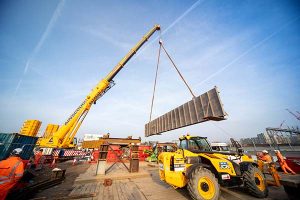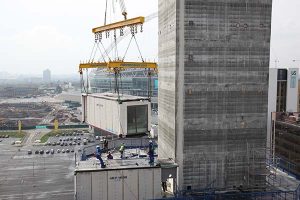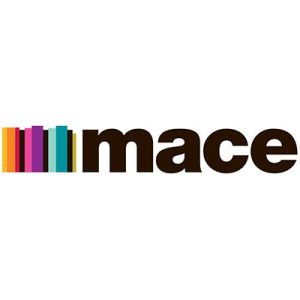The video production process is divided into three stages: Pre-production, Production and Post-production. Here we detail what is involved during the making of your video. A Step by Step guide to construction video production
A. Pre-production
The Brief-Define your Audience, Messaging and Objectives
Who is your target audience? Potential clients? Staff? We will tailor your video content to reach and engage this audience.
We encourage a collaborative approach, we can then help you define the key objectives you want to achieve and we will advise on an appropriate creative direction. What you want to say them will be reflected in the script and the storyboard.
Don’t worry if you don’t know exactly what you want, we are an innovative video production company that love to create exciting concepts and proposals. This Step by Step guide to construction video production will help you.
Where will your video be shown? On social media or the home page of your web site? Thinking in advance about where it will be seen may effect what needs to be filmed.
Costings
Once you are happy with the concept we will respond with an estimate based on your requirements. We will work with you to maximise you budget. The cost of your production depends on the complexity of the brief and the length it will take to execute. Our estimates are based on what we think is the most cost effective way to produce your video. Although most clients are initially only thinking of making one film, with careful planning and use of your budget we can usually create several edits. A great opportunity to illustrate other facets of your company and increase your ROI. For a quote please visit our GET A QUOTE web page
Our Proposal and treatment
Once we have your brief we will conceive an appropriate visual idea. This is called the ‘treatment’ (the style and look of the video) and will make your story visually exciting and engaging. We have a deep knowledge of the construction industry and have made numerous videos on a huge variety of different projects so we can advise on the best way to document and promote your work.
The Script, Shot List and Storyboard
Armed with all the necessary information, script development can begin. A script indicates what the audience will see and hear. It is the ‘blue print’ of your production. Often you may already have the ‘bones’ of your script within your existing marketing material. We can help you with scriptwriting.
We can then create a storyboard/shot list enabling you to visualise the finished film. This is a series of small sketches (or photos) illustrating each scene in chronological order. This helps you envisage how the film will look and it helps us plan each shot in detail as we can see what location, how many people, what props etc are required.
Voiceover and music
Once the script has been approved you can choose a suitable voiceover artist to narrate your story. The voiceover track is then recorded in readiness for editing. An appropriate piece of music is also chosen. As this is a subjective choice, we can direct you to several recommended music library web sites and then organise the licence and purchase of your choice (included in our rates)
Recce
Ideally we ‘recce’ the site to assess the shooting environment and meet any key personnel involved. This visit enables us to assess the filming conditions and identify problems that may arise and solve them prior to the shoot dates. It is also an opportunity for the site team to ask us any questions about the filming. With the shot list in mind, we ‘scout’ for suitable locations and check availability of staff, locations and resources. If possible, it makes sense for us to undertake any induction procedures whilst we are on site. This will save time on the filming day.
If necessary we will arrange any licences or permits that need to be secured prior to filming such as CAA drone approval.
Time invested at this stage in thorough research, discussion and communication is key to a successful construction video production.
RAMS
Once we have done the recce and met with the site team we can compile our RAMS.
Pre-production meeting
This can be done virtually or in person, whichever is convenient for you. This involves discussing and planning the logistics, organisation and management of your project. Each shoot day is thoroughly planned so we get the most out of your time and budget. We compile a shoot schedule so everyone involved knows what is happening, when and where?
A pre-production meeting allows all the stakeholders the opportunity to meet our production team and ask questions. We can gather all the relevant facts, clarify all your objectives and obtain further knowledge and understanding of the project. We also discuss the organisation and logistics of the filming. The who? What? Where and When?
The Production Schedule
We compile a shooting schedule so everyone involved knows what is happening, when and where? It will detail all the shooting times, locations, personnel and required shots.




B. Production
Filming
Lights, camera, action! We execute all the shots featured in the storyboard. We aim to cause as little disruption as possible. A shoot usually involves at least two crew, shooting with several cameras and numerous lights, sound equipment and other kit. There might be more crew and equipment depending on the complexity and scale of the project.
Our production schedules are carefully planned so we can shoot every shot with care and precision. We aim to cause minimal disruption and execute the project quickly, safely, efficiently and professionally. Throughout the day our production assistants carefully check the storyboard, shot list and schedules making sure we are on time and getting every shot.
We utilise the latest 4K technology and imaging software ensuring our clients get the very best pin sharp footage and super clean sound.
C. Post-production heading
The footage, file processing and storage
The ‘raw’ footage (digital files) are processed and securely backed up. It is then imported into the editing software together with the voiceover and music. We then log, catalogue and assess all the footage.
Editing the initial, ‘rough cut’ video
We create a ‘rough cut’ edit as per the storyboard. The shots are placed in the appropriate order and then we start to build the film, creating each scene by combining various camera angles, live sound, the voiceover, titles and music, making any necessary adjustments as we progress.
This is uploaded to our secure on-line platform for all stakeholder to view. Depending on the complexity of the project and the number of edits required this will usually be within seven days of the shoot.
Client feedback
We request that all the required changes (with approximate timings) from all the stakeholders is submitted in one document.
Creating the final video
Once we have feedback from all stakeholders, we make any changes required. This process maybe repeated several times until you are happy.
Colour grading and sound mixing
We then colour grade the footage, ensuring all the video is uniform in appearance. The sound is mixed so the music and dialogue are crisp and audibly clear.
Delivery
We supply the approved edit in a file format suitable to your needs. This can be downloaded form our secure on-line platform or we can securely send you the file.
Alternatively we can host your video and it can be embedded within your web site. This ensures your video is always displayed at the very best quality and there will be no playback issues.
A Brief Guide to Creating a Construction Video
Creating a construction video involves several steps, from planning and shooting to editing and post-production. Here’s a step-by-step guide to help you create an engaging construction video:
- Define Your Objective: Determine the purpose of your construction video. Are you showcasing a specific project, promoting your construction services, or creating a safety training video? Knowing your objective will guide the entire production process.
- Develop a Script/Storyboard: Write a scrip guide to Creating a Construction Videot or create a storyboard that outlines the sequence of shots and scenes you want to include in the video. Include narration or text if needed to provide context and information.
- Gather Equipment: Ensure you have the necessary video production equipment. This may include cameras (DSLR, mirrorless, or professional video cameras), tripods, stabilizers, microphones, and lighting equipment.
- Choose the Right Location and Time: Select the construction site or project you want to feature in the video. Plan the shooting schedule to capture the site during different stages of construction for a more dynamic video.
- Ensure Safety Compliance: Prioritize safety during the shooting process. Make sure everyone involved in the production, including crew members and construction workers, follows safety protocols and wears appropriate protective gear.
- Capture Footage: Start filming according to your storyboard/script. Capture various shots, including establishing shots of the construction site, close-ups of tools and construction activities, time-lapse footage to show progress, and interviews with project managers or workers.
- Record Narration or Interviews: If your video includes narration or interviews, record the audio with a high-quality microphone. Alternatively, you can add voiceovers during the editing process.
- Consider Aerial Footage: Depending on the project and location, aerial shots can provide a unique perspective. If possible, use drones to capture aerial footage of the construction site.
- Edit the Video: Transfer the footage to a video editing software. Trim and arrange the clips according to your storyboard. Add text, graphics, transitions, and music to enhance the video’s storytelling.
- Incorporate Time-Lapse: If you have captured time-lapse footage, integrate it into the video to show the project’s progress over time.
- Add Background Music: Select appropriate background music that complements the mood and message of your construction video.
- Review and Refine: Watch the edited video multiple times and make any necessary adjustments to improve the flow, pacing, and overall quality.
- Export and Share: Once you are satisfied with the final video, export it in the desired format and resolution. Upload the video to your website, social media platforms, or other relevant channels to reach your target audience.
- Promote Your Video: Share the construction video on various platforms, collaborate with construction industry influencers, and encourage viewers to engage with and share the content.
Remember to keep the video concise, informative, and visually appealing. High-quality visuals and clear audio are essential for a successful construction video that effectively communicates your message.







